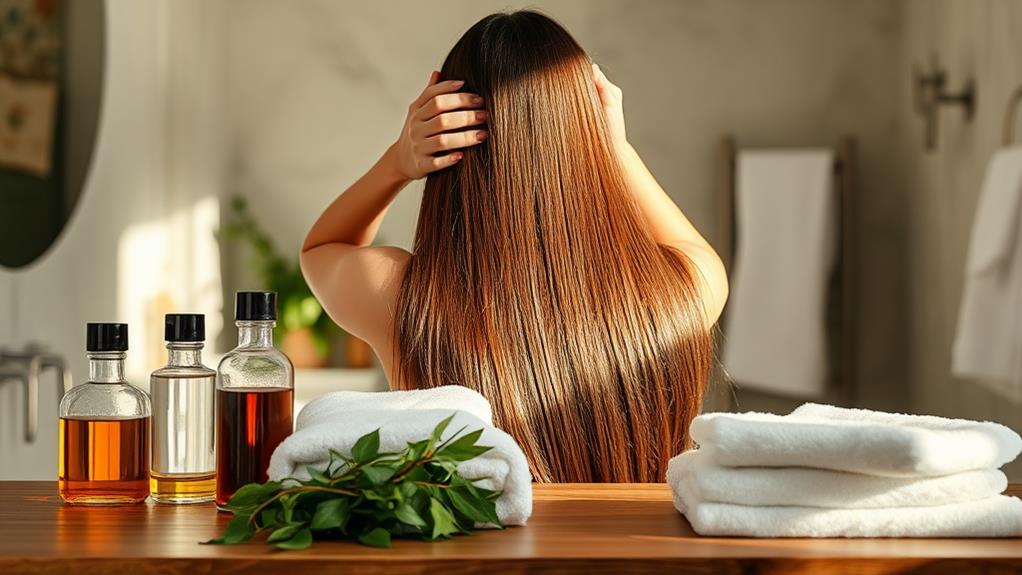When it comes to oiling your hair, understanding the right techniques can make a significant difference in the results you achieve. You need to take into account your hair type and choose an oil that aligns with your specific needs, whether it's for hydration or growth. Before you start, there are a few essential preparations to keep in mind that can enhance the process. If you're curious about how to maximize the benefits of your oiling routine and guarantee your hair looks its best, the next steps might surprise you.
Benefits of Oiling Hair

Oiling your hair can do wonders for its health and appearance. You mightn't realize it, but those shiny locks you see in magazines often come from a little TLC in the form of oil.
When you oil your hair, you're giving it a deep conditioning treatment that can help nourish the scalp and strengthen the strands. This means less breakage and fewer split ends, which is a win-win!
Plus, oiling can help keep your scalp hydrated, reducing dryness and flakiness. No one wants a snowy scalp!
By regularly massaging oil into your hair, you also boost blood circulation, which can promote hair growth. Imagine your hair growing like a weed—well, a pretty weed!
Don't forget about the shine factor! Oiling can give your hair that glossy look that turns heads. It also helps tame frizz, making it easier to manage on those unruly hair days.
So, why not indulge in a little oiling ritual? Your hair deserves it, and your future self will thank you for those fabulous, healthy strands.
Choosing the Right Oil
Finding the right oil for your hair can make all the difference in achieving those stunning results. With so many options out there, it can feel a bit overwhelming. But don't worry, I'm here to help you navigate this oily adventure!
First up, think about your hair type. If you've got dry or curly hair, coconut oil is a fantastic choice. It's super moisturizing and helps tame those wild curls.
On the flip side, if your hair tends to be oily, you might want to try lighter oils like argan or jojoba. They condition without weighing your hair down.
Then, consider your hair goals. Are you looking for growth? Castor oil is known for promoting hair growth and thickness.
Want to add shine? A little bit of olive oil can work wonders!
And don't forget about your scalp! If you have dandruff or an itchy scalp, tea tree oil could be your new best friend.
Just remember to dilute it with a carrier oil, so it's not too strong.
Preparation Before Oiling

Before you immerse yourself in the delightful world of hair oiling, it's essential to prepare your hair and scalp properly.
First things first, make sure your hair is clean and dry. Oiling on dirty hair can trap dirt and make your efforts go to waste. So, give your hair a good wash and let it dry completely.
Next, check for any knots or tangles. You don't want to deal with those pesky tangles while you're trying to oil your hair! Gently brush or comb your hair to smooth it out.
Also, think about your scalp. If it's feeling a bit itchy or flaky, a gentle scrub with a mild exfoliant can help. This'll prep your scalp for the oil, making it more effective.
Finally, gather your supplies. You'll need your chosen oil, a towel to protect your clothes, and maybe a bowl if you're using a thicker oil. Preparing your space is key!
With all this done, you're ready to plunge into the fun part—oiling your hair! Trust me, your locks will thank you later.
Proper Application Techniques
Your hair deserves the best treatment, and applying oil correctly is essential for maximizing its benefits.
First, you'll want to choose the right oil for your hair type. Whether it's coconut, argan, or almond oil, each has unique perks.
Once you've got your oil, warm it slightly in your hands. This helps it spread easily and opens up your hair cuticles.
Now, section your hair into manageable parts. Start from the roots and work your way down to the tips. Use your fingertips to gently massage the oil into your scalp. This not only nourishes your hair but also boosts blood circulation—kind of like a spa day for your head!
Don't forget the ends! They're often the driest, so give them a little extra love.
If you've got long hair, consider using a comb to distribute the oil evenly.
Frequency of Oiling

While you might be enthusiastic to oil your hair daily for maximum benefits, it's important to find a frequency that suits your hair type and lifestyle. Oiling your hair too often can lead to greasiness, while not doing it enough might leave it dry and frizzy. So, what's the magic number?
If you have dry or curly hair, you might want to oil it two to three times a week. This will help lock in moisture and keep those curls bouncy and shiny.
On the other hand, if your hair is fine or oily, once a week could be enough. You don't want to weigh it down, right?
Also, consider your schedule. If you're always on the go, maybe once a week works better for you.
But if you love pampering yourself, feel free to indulge in a little extra oil time! Just remember, balance is key.
Listen to your hair; it'll let you know what it needs. So, grab that oil and find your perfect rhythm. Your hair will thank you for it, and who doesn't love a little extra shine?
Post-Oiling Care Tips
Oiling your hair is just the beginning; proper post-oiling care is essential for maximizing its benefits.
After you've given your hair that nourishing treat, it's time to rinse it out. Use a mild shampoo, and don't forget to lather twice! The first wash helps remove the oil, while the second makes sure your hair feels fresh and clean.
Conditioning is key, too. Grab a good conditioner and apply it to the ends of your hair, where it needs moisture the most. Let it sit for a few minutes while you do a little dance—because, why not?
When you're done, rinse with cool water. This helps to seal your hair cuticles, making your hair shinier and smoother.
Also, try to avoid heat styling tools for a day or two. Your hair just had a spa day, and it deserves a break!
Lastly, embrace your natural shine. You might notice your hair feels softer and looks healthier.
